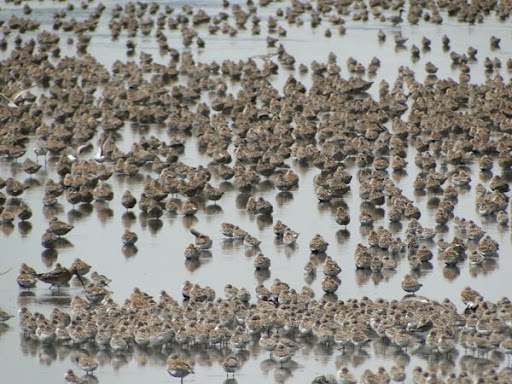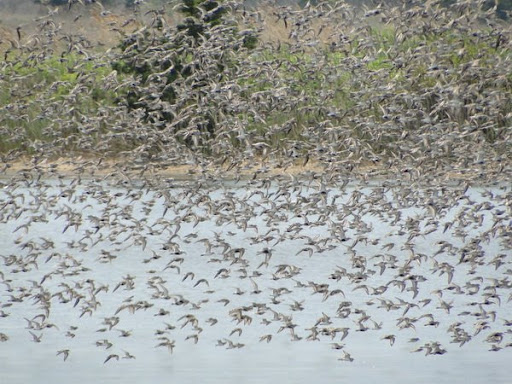 Peter Pan is the Never Land boy who never grows up, ruling his Lost Boys and constantly harassing the villainous Captain Hook and hapless Smee. He is guarded and assisted by the jealous pixie, Tinker Bell, whose voice is like the tinkling of a bell, and who sprinkles pixie dust to make you fly.
Peter Pan is the Never Land boy who never grows up, ruling his Lost Boys and constantly harassing the villainous Captain Hook and hapless Smee. He is guarded and assisted by the jealous pixie, Tinker Bell, whose voice is like the tinkling of a bell, and who sprinkles pixie dust to make you fly.In the stage productions of Peter Pan, Tinker Bell was a bobbing point of light. When Walt Disney animated the story in 1953, animators made her into a sexy young woman rumored to have been modeled on Marilyn Monroe, which probably encouraged dads to bring their children to the movie theater. The pixie hovers and dips and darts; she pauses in mid air, does a deep “u” dip, and pauses again before dashing elsewhere.
The flight of the spritely Tinker Bell in Disney’s animated feature is like the flight of the terns, particularly the small terns, like the Common, Forster’s or Least Tern. These feathered, almost ephemeral, pixies swirl on the wind currents with delicacy and sureness. I was going to try to describe their flight and fishing style until I read Edward Forbush’s account. Here are pieces of his writing about Common Terns fishing off the Massachusetts coast:
“High in the sunlight they hover above the surging sea ... The whirling, screaming, light-winged birds ... alternately climb the air and plunge like plummets straight down into the waves – rising again and again, fluttering, poising, screaming, striking ... shooting down into the angry waves. They played with gale and sea. Rising, they shook the brine from their feathers, and towering high, hovered a moment, breasting the gale; then setting their wings like long, barbed spearheads, plunged again and yet again.”
I love watching the terns as they hover over some tidal marsh or impoundment -- as they troll the waters of an estuary, or balance on the wind above ocean waves. Their flight style has given them the name, “sea swallows,” but for gracefulness in the air, they make the land swallows look like lumbering elephants.

 Early this month in Cape May, I watched the same prenuptial routine along a narrow tidal estuary, this time by a pair of Forster’s Terns. She perched on a piling, while he went off fishing. She signaled his return by calling. But on several occasions, it took him an inordinately long time to return - at least in her opinion - and her calls were not to welcome him back but to protest his delay. Even so, she must have been satisfied on the whole, for after being fed to her fill, bowing and posturing with him, she allowed him to perch on the same piling. Finally they took wing together, perhaps for an aerial courtship, flying high and gliding downward.
Early this month in Cape May, I watched the same prenuptial routine along a narrow tidal estuary, this time by a pair of Forster’s Terns. She perched on a piling, while he went off fishing. She signaled his return by calling. But on several occasions, it took him an inordinately long time to return - at least in her opinion - and her calls were not to welcome him back but to protest his delay. Even so, she must have been satisfied on the whole, for after being fed to her fill, bowing and posturing with him, she allowed him to perch on the same piling. Finally they took wing together, perhaps for an aerial courtship, flying high and gliding downward.
The terns may have a pixie-like, Tinker Bell-ish character to their flight, but this feeding courtship is all practical. The female needs a mate who will help her feed their voracious young. Last summer at Plum Island, I watched Common Terns feeding their recently fledged young.  The young vocalized their demand for food with an insistence that made my impatient female Forster’s sound like the epitome of laid-back patience.
The young vocalized their demand for food with an insistence that made my impatient female Forster’s sound like the epitome of laid-back patience.
Here’s a brief run-down on our New England terns, Genus Sterna. The Caspian Tern is the largest tern and can be found on Lake Champlain and the southern New England Coast. Least Tern is the smallest tern and is generally close to the coast. Roseate Tern is only found on the seaboard and is considered endangered in the northeast; a few are nesting with other tern colonies on offshore islands. A few Arctic Terns breed on offshore islands in the northeast; seldom seen from land, this tern spends most of its life at sea and is the champion long range migrant, ranging from the high Arctic during our summer to the Antarctic during our winter. The Common Tern is common in the northeast; further south along the coast and inland it is outnumbered by the Forster’s Tern.
Common Tern and Forster’s Tern are readily identified in their winter plumage (check your field guide to see the differences). But they are identification nightmares in breeding plumage. Then differences are subtle. John James Audubon correctly identified the Common Tern of North America as the same species as the Europe’s Common Tern. However, Audubon only knew the Forster’s Tern in its winter plumage: “I shot several individuals of this species out of a number congregated on the broad eddies opposite New Orleans, in 1820 .... Since that time it had not been my fortune to meet with any birds of the same species, until I visited Texas in the spring of 1837, when two of them were procured.”
Forster’s Terns winter along the Gulf Coast; some (probably young birds) retain their winter plumage through the summer. Common Terns winter in the tropics. When they return north, they may mingle with the almost indistinguishable Forster’s Terns in breeding plumage. Audubon certainly saw Forster’s Terns in breeding plumage, and probably collected some. He just did not recognize them as different from Common Terns.
Parenthetically, Forster’s Tern is named in honor of Johann Forster who accompanied Captain Cook on his voyage around the world in 1772, and who wrote an ornithological treatise on the birds of Hudson Bay. Thomas Nuttall, an English and American ornithologist, bestowed the name. Audubon named it Havell’s Tern, in honor Robert Havell, “one of the best ornithological engravers in England.”
 Audubon’s failure to recognize the difference between breeding plumage Forster’s and Common Terns, puts him in a crowded company. I am beginning to get some handle on the differences between the two, but ... if you bird with me and I tell you we are looking at a Common Tern, I will reserve the right to change my opinion (as I will also do with many other species). I have recently reexamined all of my photographs of Common Terns and Forster’s Terns and find that I need to reclassify a number of those photographs.
Audubon’s failure to recognize the difference between breeding plumage Forster’s and Common Terns, puts him in a crowded company. I am beginning to get some handle on the differences between the two, but ... if you bird with me and I tell you we are looking at a Common Tern, I will reserve the right to change my opinion (as I will also do with many other species). I have recently reexamined all of my photographs of Common Terns and Forster’s Terns and find that I need to reclassify a number of those photographs.
What I will not reclassify is my delight in watching these birds fly. The terns are masters on the wing - delicate waifs - flimsy, feathery wisps - pixies of the air. Yet they are undeterred by the storms and gales that pound our shores and roil the oceans.
(Post of "Tailfeathers," Brattleboro Reformer, 5/29/09.)Quotes: Forbush & May, A Natural History of American Birds, 1953. John James Audubon, The Birds of America, 1840-1844
Notes on Photographs (in order of appearance):
Forster's Tern - silver-white primaries, long forked tale, beak orange w/black tip (05/09, Cape May)
Least Terns - (04/08, Green Cay, FL)
Forster's Terns - (05/09, Jake's Landing, NJ)
Common Terns - juvenile & adult - adult's beak orange-red (usually darker than Forster's), tail shorter than wings & primaries dark (08/08 - Plum Island, MA)
Forster's Tern - (05/09 - Brigantine, NJ)
Additional Photos:
Common Tern - Note dark primaries (05/08 - over ocean, Jake's Landing, NJ)
 Common Tern - dark wedge on primaries - red-orange beak w/o black tip which is sometimes lost mid to late summer. (08/08 - Plum Island, MA)
Common Tern - dark wedge on primaries - red-orange beak w/o black tip which is sometimes lost mid to late summer. (08/08 - Plum Island, MA) Least Tern - smallest tern, yellow beak, short wedged tail - (05/09 - Nature Conservancy, Cape May, NJ). (For photos of Least Tern in flight, see Steve's "Shooting My Universe" in the blogs I follow.)
Least Tern - smallest tern, yellow beak, short wedged tail - (05/09 - Nature Conservancy, Cape May, NJ). (For photos of Least Tern in flight, see Steve's "Shooting My Universe" in the blogs I follow.) Forster's Tern - courting pair at rest - light primaries, yellow bill - (05/09 - Jake's Landing, NJ)
Forster's Tern - courting pair at rest - light primaries, yellow bill - (05/09 - Jake's Landing, NJ) This exercise was done mostly for my benefit as I try to get a firmer handle on IDing Common & Forster's. I hope I got it right, and I hope it might also be helpful.
This exercise was done mostly for my benefit as I try to get a firmer handle on IDing Common & Forster's. I hope I got it right, and I hope it might also be helpful.Good birding!












































